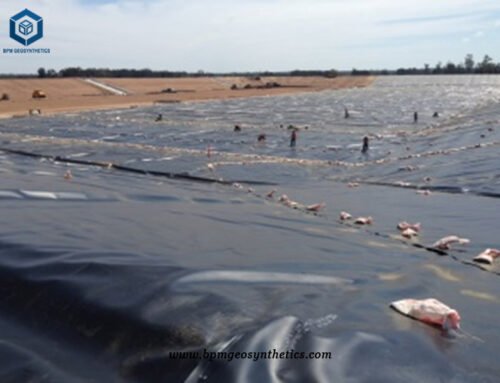Composite drainage nets, also known as composite drain nets, are synthetic materials designed to provide efficient drainage in various applications, particularly in landfill projects. The demand for composite drainage nets has been steadily increasing worldwide due to the growing number of landfills. Compared to traditional sand and gravel drainage systems, composite drainage nets offer higher drainage efficiency. They effectively channel water away from the landfill site, preventing the accumulation of excess moisture, and facilitating proper waste management.
1. What Are Composite Drainage Nets?
Composite drainage nets are geotechnical materials used for efficient drainage in various applications, particularly in landfill projects. They are constructed by combining different layers of materials through a special process.
The manufacturing process of composite drainage nets involves several steps. Initially, HDPE (high-density polyethylene) particles are heated and stirred in a dryer to remove moisture. The dried particles are then fed into a high-temperature feeding cylinder through a spiral funnel extruder. The particles undergo a high-temperature melt plasticizing process as they pass through the cylinder. Finally, the molten material is extruded through a mold and cooled to form the composite drainage nets.
The composite drainage nets consist of multiple layers. They typically include a drainage network, which allows water to flow through and be effectively channeled away, preventing the accumulation of excess moisture. This drainage network is sandwiched between a finished drainage network and a geotextile base cloth. The finished drainage network provides a smooth surface for water flow, while the geotextile base cloth provides additional reinforcement and filtration properties.
Composite drainage nets is designed and engineered with long service life. They are designed to be durable and resistant to wear and tear. This durability reduces the need for frequent replacements, leading to cost savings in landfill construction and maintenance projects. It is estimated that the use of composite drainage nets can save up to 30% of the total cost compared to traditional drainage systems.
Composite drainage nets are geologically friendly materials that offer efficient drainage capabilities. Through their unique construction and long service life, they provide cost-effective solutions for managing water flow in landfill projects and other applications.
2. What Are Advantages of Composite Drainage Nets for Landfill Project in Malaysia?
Composite drainage nets in landfill projects have strong drainage capacity, high strength, prevention of geotextile embedding, and impressive compression load-bearing capabilities. These advantages contribute to efficient waste management, long-term stability, and cost-effectiveness in landfill construction and maintenance.
2.1 Strong drainage capacity
Composite drainage nets have excellent drainage capabilities, allowing for efficient water flow and preventing the accumulation of excess moisture. They can handle high-pressure loads over an extended period.
2.2 High tensile strength and shear strength
The composite drainage nets possess superior tensile strength and shear strength, ensuring their durability and resistance to deformation. This strength allows them to withstand the stresses and pressures associated with landfill environments.
2.3 Prevention of geotextile embedding
The inclusion of a geotextile base cloth in composite drainage nets helps prevent the geotextile from becoming embedded within the drainage core. This protects the long-term stability of water conductivity and ensures continuous drainage functionality.
2.4 Compression load-bearing capacity
Three-dimensional composite drainage nets have a remarkable capacity to bear compression loads. They can withstand pressures exceeding 2000 kPa, which exceeds the compressible capacity of ordinary drainage networks. This makes them suitable for handling the weight and stress associated with landfill operations.



3. Case Study of Composite Drainage Nets for Landfill Project in Malaysia
In a case study involving BPM Malaysia, a customer from Malaysia contacted the company in need of composite drainage nets for a landfill project. As soon as BPM received the inquiry, they engaged in communication with the customer to gather project details and understand their requirements. In response, BPM provided the customer with comprehensive information, including pictures and videos showcasing the production process, product performance, and specifications of the composite drainage nets.
Recognizing the customer’s need to evaluate the product, BPM promptly arranged for samples to be sent to the customer for testing. After one week, the customer received the samples and conducted the necessary tests. The customer expressed great satisfaction with the test results, confirming the quality and suitability of the composite drainage nets for their landfill project.
Impressed with the performance of the samples, the customer decided to proceed with an order. They planned to initially order 50,000 square meters of composite drainage nets from BPM. The specified composite drainage net had a 7mm HDPE net composite with a 200g/m2 filament geotextile. The size of each roll was 2m*30m.
BPM Malaysia demonstrated their commitment to providing excellent customer service and meeting the needs of the customer throughout the communication and sample testing process. By promptly addressing the customer’s inquiries, providing detailed information, and delivering satisfactory samples, BPM established a strong rapport with the customer. The customer’s decision to place an order for 50,000 square meters of composite drainage nets reflects their confidence in BPM’s product quality and suitability for their landfill project.
This case study highlights BPM’s ability to understand and fulfill customer requirements, ensuring customer satisfaction and establishing long-term partnerships. By delivering reliable and high-quality composite drainage nets, BPM Malaysia continues to serve the needs of customers in various projects, including landfill construction and maintenance.
4. About BPM Geosynthetics
BPM has been specializing in delivering one stop geosynthetics products and solutions to worldwide customers since its foundation in 2007. BPM had provided many types of effective and state of the art geomembranes, geotextiles, geocells, geosynthetic clay liners (GCLs), drainage boards, geogrids to over 81 countries.
BPM geosynthetics is not only manufacturing best quality geosynthetic products but also providing professional design and installation service. OEM, ODM, custom development and fabrication are also available. If you have any questions or inquiries, please contact us, we will reply as soon as possible.





